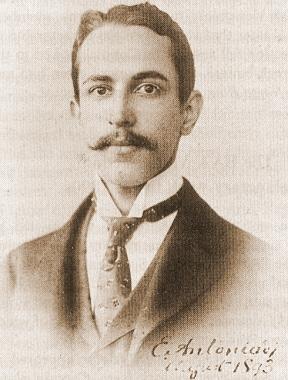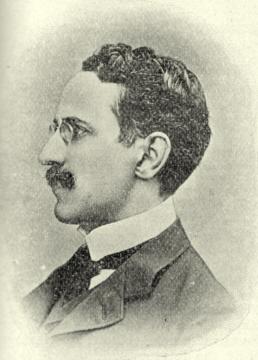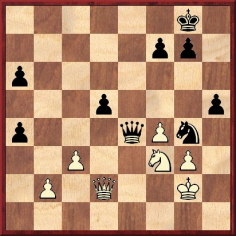
Edward Winter

Richard McKim (Peterborough, England) has written to us regarding the non-chess activities of a little-known player, about whom he has written the only biography: ‘The Life and Times of E.M. Antoniadi’ in the Journal of the British Astronomical Association, volume 103, No. 4, pages 164-170 (1993) and volume 103, No. 5, pages 219-227 (1993).
Our correspondent writes:
‘He was born in Constantinople on 1 March 1870, of Greek parents, his given name being Eugenios Mihail Antoniadis. He died in Paris on 10 February 1944. (Source for both dates: Antoniadi’s death certificate.) His first publications date from the late 1880s, and his last ones from 1941 or 1942. Eugène Michael (in French, Eugène-Michel) Antoniadi was the name he later used, as he spent most of his life in France (1893 onwards). He is best known for his work concerning the planets Mars and Mercury, and drew the best pre-Space Age maps of them. In 1909, using the great 83-cm aperture refracting telescope of the Meudon observatory near Paris under ideal observing conditions, he demonstrated that the so-called “canals” of Mars were optical illusions. Antoniadi was also a noted historian, as well as a superb artist, writing about the pyramids and Egyptian astronomy. In the early twentieth century he further demonstrated his skills as an architect by compiling a great three-volume work on the mosque of St Sophia in Constantinople (now Istanbul).’

E.M. Antoniadi
We add now an account of Antoniadi’s chess career. Its high spot came in a tournament in Paris in 1907; with a score of +6 –1 (a loss to de Villeneuve) =0 he came equal first with Marshall, a point ahead of Tartakower. In the three-game play-off, Marshall won the first game and the other two were drawn. Antoniadi commented:
‘Until now I have had few opportunities to face top-rank players, but I have studied a great deal. Firstly, with the excellent ABC des Echecs [by Preti] and then by following most faithfully the learned commentaries of Dr S. Tarrasch, whom I consider one of the best annotators of our time and of whom I am an ardent disciple.’
Source: La Stratégie, 24 July 1907, pages 258-259.
On page 132 of the June 1922 La Stratégie Antoniadi claimed that he had an equal score against Marshall (‘two games won, two lost and three draws between 1902 and 1907’) and that this success was almost entirely due to his study of Tarrasch’s books.
Below is his tournament victory over Marshall, who had played a world championship match against Lasker earlier the same year:
Frank J. Marshall – Eugène M. Antoniadi1 d4 d5 2 c4 e6 3 Nc3 Nf6 4 Bg5 Be7 5 e3 Ne4 6 Bxe7 Qxe7 7 cxd5 Nxc3 8 bxc3 exd5 9 Bd3 Nd7 10 Nf3 O-O 11 O-O Re8 12 c4 dxc4 13 Bxc4 Nb6 14 Qc2 Bf5 15 Qxf5 Nxc4 16 Rfc1 Nd6 17 Qc5 c6 18 Rab1 Ne4 19 Qc2 Rad8 20 Ne5 Nd6 21 Qa4 Nb5

22 Rxc6 Nxd4 23 exd4 bxc6 24 h3 Rd6 25 Nxc6 Qe4 26 Rc1 Rg6 27 g4 h5 28 Qc2 Qf3 29 Qb3 Qf4 30 Qc3 hxg4 31 Ne5 gxh3+ 32 Kh1 Qg5 33 White resigns.
Antoniadi annotated the game on pages 247-248 of La Stratégie, 24 July 1907, and an English translation was published on page 169 of the September 1907 American Chess Bulletin. Tarrasch’s notes to the game in the Berliner Lokal-Anzeiger were reproduced on pages 187-188 of Traité du jeu des échecs by J. Taubenhaus (Paris, 1910). Tarrasch concluded: ‘Apart from the erroneous opening, M. Antoniadi conducted the game in absolutely masterly fashion’.
A feature on ‘Mr. E.M. Antoniadi, F.R.A.S.’ [Fellow of the Royal Astronomical Society] on pages 413-415 of the September 1907 BCM reported that he had studied Staunton’s Handbook in 1888 and, later, Morphy’s Games (presumably Löwenthal’s volume). ‘In 1893 he went to France, winning several games of Sittenfeld and Janowsky, although losing the majority with both these players, and ten years later he began to study the game seriously.’ His year of birth was given as 1871.
Below is a selection of wins by Antoniadi:
Amateur – Eugène M. Antoniadi1 e4 e5 2 Nf3 Nc6 3 Bb5 Nf6 4 O-O Nxe4 5 Re1 Nd6 6 Nxe5 Be7 7 Nc3 Nxe5 8 Rxe5 O-O 9 Bd3 Bf6 10 Rh5 g6 11 Rh3 Ne8 12 b3 d6 13 g4 Bg7 14 Bb2 Nf6 15 Ne4 Nxg4 16 Bxg7 Kxg7 17 Rg3 Ne5 18 Be2 f5 19 d4 fxe4 20 dxe5 d5 21 Qd4 Be6 22 Kh1 Qe7 23 Rag1 c5 24 Qe3 Bf5 25 f4 exf3 26 Bxf3 d4 27 Qe2 Rae8 28 Re1 b6 29 Bd5 Qd7 30 Qg2 Re7 31 h4 Qe8 32 Bc6

32…Rxe5 33 Bxe8 Rxe1+ 34 Kh2 Be4 35 White resigns.
Source: La Stratégie, 15 July 1900, pages 207-208.
Eugène M. Antoniadi – Comte Jean de Villeneuve Esclapon1 e4 c5 2 Nf3 Nc6 3 d4 cxd4 4 Nxd4 e6 5 Nb5 d6 6 Bf4 e5 7 Be3 a6

8 N1c3 axb5 9 Nd5 Rb8 10 Bxb5 Bd7 11 Bb6 Qg5 12 Nc7+ Ke7 13 O-O Nf6 14 Qd3 Nd4 15 f4 Qh5 16 fxe5 Bxb5 17 exf6+ gxf6 18 Qxd4 Bg7 19 Rf5 and wins.
Source: BCM, July 1905, page 261. The game was played in that year’s Café de la Régence Championship Tournament in Paris, which Antoniadi won jointly with J.M. Lee and P. Clérissy.

E.M. Antoniadi
J. Garcin – Eugène M. Antoniadi1 e4 c6 2 d4 d5 3 e5 Bf5 4 Bd3 Bxd3 5 Qxd3 e6 6 f4 Qb6 7 Nf3 Nh6 8 Nc3 Qa6 9 Qxa6 Nxa6 10 a3 Be7 11 b4 Nc7 12 Bd2 a5 13 O-O axb4 14 axb4 Kd7 15 Na4 Ra6 16 Nc5+ Bxc5 17 bxc5 Rha8 18 Rxa6 Rxa6 19 Ng5 Ke7 20 Rb1 Nb5 21 c3 f6 22 Nf3 Kd7 23 h3 Nf5 24 Kf2 Ra2 25 g4 Nh4 26 Nxh4 Rxd2+ 27 Ke3 Rc2 28 Kd3 Rxc3+ 29 Ke2 Rxh3 30 Nf3 Nc3+ 31 White resigns.
Source: La Stratégie, July 1919, pages 146-148.
Amédée Gibaud – Eugène M. Antoniadi1 e4 c6 2 d4 d5 3 exd5 cxd5 4 Bd3 Nf6 5 h3 Nc6 6 c3 e5 7 dxe5 Nxe5 8 Qe2 Qe7 9 Bb5+ Nc6 10 Be3 Be6 11 Nf3 Qc7 12 Nbd2 Be7 13 O-O O-O 14 Nd4 Bd6 15 Rae1 Rae8 16 Qd1 a6 17 Bd3 Bh2+ 18 Kh1 Bd6 19 f4 Bc8 20 Qf3 Bc5 21 N2b3 Ba7 22 Bf2 Rxe1 23 Rxe1 Bb8 24 g3 Bxh3 25 Bf5 Bxf5 26 Nxf5 Qd7 27 Nbd4 Nxd4 28 Nxd4 Re8 29 Rxe8+ Qxe8 30 Qd1 Ba7 31 Kg1 h5 32 Qb3 Qd7 33 Kg2 Ne4 34 Be1 b5 35 Nf3 Qd6 36 Nh4 Qc5 37 Nf3 Qe3 38 Qd1 Nf6 39 a4 bxa4 40 Qd2 Qe4 41 Bf2 Bxf2 42 Kxf2 Ng4+ 43 Kg2

43…f6 44 c4 dxc4 45 f5 Ne5 46 White resigns.
Source: La Stratégie, July 1919, pages 149-150.
Eugène M. Antoniadi – Wladimir Bienstock1 d4 f5 2 c4 Nf6 3 Nc3 e6 4 a3 Be7 5 e3 O-O 6 Bd3 c6 7 Nf3 d5 8 c5 b5 9 Ne5 Ne4 10 Ne2 Bf6 11 b4 a5 12 f3 Ng5 13 Bd2 Bxe5 14 dxe5 Nf7 15 f4 axb4 16 axb4 Rxa1 17 Qxa1 Qc7 18 O-O g5 19 Nd4 g4 20 Be1 Na6 21 Nxe6 Bxe6 22 Qxa6 Bc8 23 Qa2 Nd8 24 Bh4 Kg7 25 Bf6+ Kg6 26 Qf2 Qa7 27 Qh4 Nf7 28 Qxg4+ Resigns.
Source: La Stratégie, July 1919, pages 151-152.
We have yet to find games played by Antoniadi outside France. Reports of his successes in Athens in 1909 seem to have been exaggerated. From page 242 of the July 1909 La Stratégie:
‘This month’s D. Schachzeitung announces (page 223) that M. Antoniadi has recently played against the strongest players in Athens, and that he has beaten them all. Messrs. Amiros and Gaspary, who were mentioned, have protested to us, stating that they cannot have lost to M. Antoniadi for the simple reason that they have not played against him.’
Antoniadi’s first notable incursion into chess history and literature was an article entitled ‘Souvenirs inédits sur Paul Morphy’ on pages 289-292 of the October 1916 La Stratégie, in which he presented C.A. Maurian’s reminiscences, on the basis of conversations and correspondence between the two men in 1911, the year before Maurian died.
On page 20 of the January 1922 issue Antoniadi wrote a complimentary review of Capablanca’s Chess Fundamentals, but the alleged faults he listed must give rise to doubts about his judgement. For example, demonstrating ignorance of British vocabulary he complained with regard to the game between F.F.L. Alexander and Sir George Thomas that Capablanca was mistaken in his use of the word ‘brackets’ (‘A la page 98, l’auteur confond les crochets avec les parenthèses.’). Such a criticism would have been worthlessly petty even if it had been factually correct.
Controversy resulted from a long general article ‘Considérations sur les Grands Maîtres de l’Echiquier’ on pages 125-134 of the June 1922 La Stratégie. To defend Morphy’s reputation Antoniadi felt obliged to attack not only Staunton (‘We have no praise to offer for either the strength or the character of Staunton, who had none of the qualities of the English nation’) but also three authors of Morphy monographs (Falkbeer, Maróczy and Sergeant), whom he accused of being jealous of Morphy and of trying to belittle him.
The article prompted a mild set of strictures from Gustave Lazard on pages 178-181 of the August 1922 La Stratégie, which Antoniadi answered on pages 230-231 of the October 1922 issue, but the real fireworks were across the Channel. P.W. Sergeant (whose book on Charousek had also been criticized by Antoniadi) defended himself vigorously in the BCM (August 1922, page 307 and September 1922, pages 348-349). Antoniadi and Sergeant clashed on pages 395-396 of the October 1922 BCM, with Sergeant being accorded the last word: ‘M. Antoniadi’s vituperative language offends my taste rather than my peace of mind.’
Sergeant wrote again about the Antoniadi dispute on pages 33-34 of his book Morphy Gleanings (London, 1932), adding in a footnote: ‘As M. Antoniadi (who was a fine player, if a bad controversialist) is dead, I will say no more about this.’
It is unclear why Sergeant considered Antoniadi already deceased at that time, but that was still the belief in chess circles in the 1980s. Page 11 of Jeremy Gaige’s 1987 book Chess Personalia gave, in Antoniadi’s death-line, ‘c1930? FRA’, although the 1994 edition (not sold commercially) revised this to ‘c1944 FRA’.

E.M. Antoniadi
(2799)
Below we give a victory with Antoniadi’s own annotations, translated from pages 66-67 of L’Echiquier Français, July-August 1909. It was a casual game played at the Café de la Régence.
A. Silbert – Eugène-Michel Antoniadi(Notes by E.M. Antoniadi)
1 e4 e5 2 Nf3 Nf6 3 Nxe5 d6 4 Nf3 Nxe4 5 d3 Nf6 6 d4 d5 7 Bd3 Bd6 8 h3 (‘A loss of time. Castling would have been preferable.’) 8...O-O 9 O-O Nc6 10 c3 (‘White’s play is too defensive.’) 10...Ne4 11 Re1 f5 12 Nbd2 Be6 13 Nf1 Qf6 14 N3h2 Rae8 (‘Black has now mobilized all his forces and has an excellent game, having gained at least three tempi in development.’) 15 f4 Qh4 (‘Pointless, as the queen cannot give check on f2 without incurring danger. White now gains a little ground.’) 16 Nf3 Qh6 17 Ne5 Bxe5 18 fxe5 Qg6 19 Qf3 Nd8 (‘The idea of putting this knight on e6 and the bishop on d7 is a good one.’) 20 Bf4 Bd7 21 Kh2 Ne6 22 Rac1 c5 (‘The start of a strong attack.’) 23 Be3 f4 (‘White’s forces are now driven back in disarray in the centre and on the king’s side, and Black remains master of the situation.’) 24 Bg1 (‘This cuts off the white king’s retreat.’) 24...N6g5

25 Qd1 (‘If 25 Qe2 then 25...f3 26 Bxe4 dxe4 27 Qf2 fxg2 28 Qxg2 Bxh3, or 28...Nf3+, with a won game; or 26...fxe2 27 Bxg6 exf1(N)+ 28 Rxf1 hxg6, and Black is a piece ahead. It is evident that if 25 Qe2 f3 26 gxf3, then 26...Nxf3+, followed by mate in a few moves.’) 25...Qh6! (‘With the idea of sacrificing a piece on h3, a combination against which there is no defence.’) 26 Bxe4 Nxh3 27 White resigns.
(4346)

Acknowledgment: The first and third photographs of Antoniadi are from Dr McKim’s above-mentioned article and are reproduced with the permission of the Journal of the British Astronomical Association.
To the Chess Notes main page.
To the Archives for other feature articles.
Copyright 2007 Edward Winter. All rights reserved.